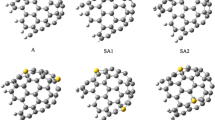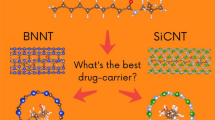Abstract
Due to the importance of soluble nanotubes in biological systems, computational research on DNA base functionalized nanotubes is of interest. This study presents the quantitative results of Monte Carlo simulations of Li-doped silicon carbide nanotubes and its nucleic acid base complexes in water. Each species was first modeled by quantum mechanical calculations and then Monte Carlo simulations were applied to study their properties in aqueous solution. Solvation free energies were computed to indicate the solvation behavior of these compounds. The computations show that solvation free energies of the complexes of DNA bases with Li-doped SiC nanotubes are in the order: thymine > cytosine > adenine > guanine. The results of complexation free energies were also used to study the stability of related structures, which indicate that thymine-Li-doped SiC nanotubes produce the most stable compound among the four DNA base complexes.





Similar content being viewed by others
References
Martin CR, Kohli P (2003) The emerging field of nanotube biotechnology. Nat Rev Drug Discov 2:29–37
Lin Y, Taylor S, Li HP, Fernando KAS, Qu LW, Gu LR, Wang W, Zhou B, Sun YP (2004) Advances toward bioapplicationsofcarbon nanotubes. J Mater Chem 14:527–541
Bianco A, Kostarelos K, Prato M (2005) Applications of carbonnanotubes in drug delivery. Curr Opin Chem Biol 9(6):674–679
Kam NWS, Dai HJ (2005) Carbon Nanotubes as intracellular proteintransporters: generality and biological functionality. J Am Chem Soc 127:6021–6026
Kam NWS, O’Connell M, Wisdom JA, Dai HJ (2005) Carbon nanotubes as multifunctional biological transporters and near-infrared agents for selective cancer cell destruction. Proc Natl Acad Sci USA 102(33):11600–11605
Wu WWS, Pastorin G, Benincasa M, Klumpp C, Briand JP, Gennaro R, Prato M, Bianco A (2005) Targeted delivery of amphotericinB to cells by using functionalized carbon nanotubes. Angew Chem Int Ed 44(39):6358–6362
Kam NWS, Liu ZA, Dai HJ (2006) Carbon nanotubes asintracellular transporters for proteins and DNA: an investigation of theuptake mechanism and pathway. Angew Chem Int Ed 45:577–581
Kuzmany H, Kukovecz A, Simon F, Holzweber M, Kramberger C, Pichler T (2004) Functionalization of carbon nanotubes. Synth Met 141(1):113–122
Johnston HJ, Hutchison GR, Christensen FM, Peters S, Hankin S, Aschberger K, Stone V (2010) A critical review of the biological mechanisms underlying the in vivo and in vitro toxicity of carbon nanotubes: the contribution of physico-chemical characteristics. Nanotoxicology 4(2):207–246
Lam CW, James JT, McCluskey R, Arepalli S, Hunter RL (2006) A review of carbon nanotube toxicity and assessment of potential occupational and environmental health risks. Crit Rev Toxicol 36(3):189–217
Murr LE, Garza KM, Soto KF, Carrasco A, Powell TG, Ramirez DA, Guerrero PA, Lopez DA, Venzor J (2005) Cytotoxicity assessment of some carbon nanotubes and related carbon nanoparticle aggregates and the implications for anthropogenic carbon nanotube aggregates in the environment. Int J Environ Res Public Health 2(1):31–42
Park EJ, Roh J, Kim SN, Kang MS, Lee BS, Kim Y, Choi S (2011) Biological toxicity and inflammatory response of semi-single-walled carbon nanotubes. PLoS One 6(10):e25892
Mwangi JN, Wang N, Ritts A, Kunz JL, Ingersoll CG, Li H, Deng B (2011) Toxicity of silicon carbide nanowires to sediment-dwelling invertebrates in water or sediment exposures. Environ Toxicol Chem 30(4):981–987
Zhang YF, Huang HC (2008) Comput Mater Sci 43:664–669
Mpournpakis G, Froudakis GE, Lithoxoos GP, Samios J (2006) Nano Lett 6:1581–1583
Zhao MW, Xia YY, Li F, Zhang RQ, Lee ST (2005) Phys Rev B 71:085312-1-7
Cicero G, Galli G (2004) J Phys Chem B 108:16518–16524
Haeri HH, Ketabi S, Hashemianzadeh SM (2012) J Mol Model 18:3379–3388
Mavrandonakis A, Froudakis GE, Schnell M, Muhlhäuser M (2003) From pure carbon to silicon-carbon nanotubes: an ab-initio study. Nano Lett 3:1481–1484
Sun XH, Li CP, Wong WK, Wong NB, Lee CS, Lee ST, Teo BK (2002) Formation of silicon carbide nanotubes and nanowires via reaction of silicon (from disproportionation of silicon monoxide) with carbon nanotubes. J Am Chem Soc 124:14464–14471
Zhao MW, Xia YY, Li F, Zhang RQ, Lee S-T (2005) Strain energy and electronic structures of silicon carbide nanotubes: density functional calculations. Phys Rev B 71:085312.1–085312.6
Miyamoto Y, Yu BD (2002) Computational designing of graphitic silicon carbide and its tubular forms. Appl Phys Lett 80:586–588
Menon M, Richter E, Mavrandonakis A, Froudakis G, Andriotis AN (2004) Structure and stability of SiC nanotubes. Phys Rev B 69:115322.1–115322.4
Menon M, Richter E, Mavrandonakis A, Froudakis G, Andriotis AN (2004) Phys Rev B69:115322–115334
Mananghaya M, Rodulfo E, Santos GS, Villagracia A (2012) Theoretical investigation on the solubilizationin water of functionalized single-wall carbon nanotubes. J Nanotechnol 2012:1–6
Star A, Liu Y, Grant K, Ridvan L, Stoddart JF, Steuerman DW, Diehl MR, Boukai A, Heath JR (2003) Noncovalent side-wallfunctionalization of single-walled carbon nanotubes. Macromolecules 36(3):553–560
Chen RJ, Zhang Y, Wang D, Dai HJ (2001) Noncovalentsidewallfunctionalization of single-walled carbon nanotubes for protein immobilization. J Am Chem Soc 123(16):3838–3839
Dyke CA, Tour JM (2004) Covalent functionalization of single-walled carbon nanotubes for materials applications. J Phys Chem A 108(51):11151–11159
Prato M, Bianco A (2003) Can carbon nanotubes be considered useful tools for biological applications. Adv Mater 15(20):1765–1768
Huang W, Taylor S, Fu K, Lin Y, Zhang D, Hanks TW, Rao AM, Sun YP (2002) Attaching proteins to carbon nanotubes via diimideactivatedamidation. Nano Lett 4:311–314
Lin Y, Allard LF, Sun YP (2004) Protein-affinity of singlewalledcarbon nanotubes in water. J Phys Chem B 108(12):3760–3764
Bianco A, Kostarelos K, Partidos CD, Prato M (2005) Chem Commun 5:571–577
Lacerda L, Bianco A, Prato M, Kostarelos K (2008) J Mater Chem 18:17–22
Lu F, Gu L, Meziani MJ, Wang X, Luo PG, Veca LM, Cao L, Sun YP (2009) Adv Mater 21:139–152
Gowtham S, Scheicher RH, Pandey R, Karna SP, Ahuja R (2008) Nanotechnology 19:125701-1-6
Zheng M, Jagota A, Semke ED, Diner BA, Mclean RS, Lustig SR, Richardson RE, Tassi NG (2003) Nat Mater 2:338–342
Wang Y (2008) J Phys Chem C 112:14297–14305
Varghese N, Mogera U, Govindaraj A, Das A, Maiti PK, Sood AK, Rao CNR (2009) ChemPhysChem 10:206–210
Zhao C, Peng Y, Song Y, Ren J, Qu X (2008) Small 4:656–661
Gao X, Xing G, Yang Y, Shi X, Liu R, Chu W, Jing L, Zhao F, Ye C, Yuan H, Fang X, Wang C, Zhao Y (2008) J Am Chem Soc 130:9190–9191
Umadevi D, Sastry GN (2011) Quantum mechanical study of physisorption of nucleobaseson carbon materials: graphene versus carbon nanotubes. J Phys Chem Lett 2:1572–1576
Zhong X, Slough WJ, Pandey R, Friedrich C (2012) Interaction of nucleobases with silicon nanowires: a first-principles study. Chem Phys Lett 553:55–58
Kharisov BI, Kharissova OV, Gutierrez HL, Méndez UO (2009) Ind Eng Chem Res 48:572–590
Gu Z, Liang F, Chen Z, Sadana A, Kittrell C, Billups WE, Hauge RH, Smalley RE (2005) In situ Raman studies on lithiated single-wall carbon nanotubes in liquid ammonia. Chem Phys Lett 410(4):467–470
Hashemianzadeh SM, FarajiSh, Amin A, Ketabi S (2008) Theoretical study of the interactions between isolated DNA bases and various groups IA and IIA metal ions by ab initio calculations. Monatshefte fur chemie, chemical monthly 139: 89–100
Leach AR (1996) Molecular modeling—principles and application. Longman, Essex
Redmill PS, Capps SL, Cummings PT, McCabe C (2009) A molecular dynamics study of the Gibbs free energy of solvation of fullerene particles in octanol and water. Carbon 47:2865–2874
Jorgensen WL, Chandrasekhar J, Madura JD, Impey RW, Klein ML (1983) Comparison of simple potential functions for simulating liquid water. J Chem Phys 79:926–935
Jorgensen WL (1981) Transferable intermolecular potential functions for water, alcohols, and ethers. Application to liquid water. J Am Chem Soc 103:335–340
Jia Y, Wang M, Wu L (2007) Sep Sci Technol 42:3681–3695
Lithoxoos GP, Samios J (2008) J Phys Chem C 112:16725–16728
Aaqvist J (1990) Ion-water interaction potentials derived from free energy perturbation simulations. J Phys Chem 94(21):8021–8024
Pranata J, Wierschke SG, Jorgensen WL (1991) J Am Chem Soc 113:2810–2819
Hansen JP, McDonald IR (1991) Theory of simple liquids. Academic, London
Beveridge DL, Capua D, Annu FM (1989) Rev Biophys Biophys Chem 18:431
Monajjemi M, Ketabi S, Hashemian Zadeh M, Amiri A (2006) Biochem Mosc 71(1):S1–S8
Lippert B (2000) Coord Chem Rev 200–202:487–516
Petersson GA, Al-Laham MA (1991) A complete basis set model chemistry. II. Open-shell systems and the total energies of the first-row atoms. J Chem Phys 94:6081–6090
Schmidt MW, Baldridge KK, Boatz JA, Elbert ST, Gordon MS, Jensen JH, Koseki S, Matsunaga N, Nguyen KA, Su SJ, Windus TL, Dupuis M, Montgomery JA (1993) J Comput Chem 14:1347–1363
Metropolis N, Rosenbulth AW, Rosenbulth MN, Teller AH, Teller E (1953) Equation of state calculations by fast computing machines. J Chem Phys 21:1087–1093
Wang Y (2008) Theoretical evidence for the stronger ability of thymine to disperse SWCNT than cytosine and adenine: self-stacking of DNA bases vs their cross-stacking with SWCNT. J Phys Chem C 112:14297–14305
Zheng M, Jagota A, Semke ED, Diner BA, Mclean RS, Lustig SR, Richardson RE, Tassi NG (2003) DNA-assisted dispersion and separation of carbon nanotubes. Nat Mater 2(5):338–342
Das A, Sood AK, Maiti PK, Das M, Varadarajan R, Rao CNR (2008) Chem Phys Lett 453:266–273
Gowtham S, Scheicher RH, Ahuja R, Pandey R, Karna SP (2007) Phys Rev B 76:033401-1-4
Antony J, Grimme S (2008) Phys Chem Chem Phys 10:2722–2729
Kollman PA (1993) Chem Rev 93:2395–2417
Author information
Authors and Affiliations
Corresponding author
Rights and permissions
About this article
Cite this article
Ketabi, S., Hashemianzadeh, S.M. & MoghimiWaskasi, M. Study of DNA base-Li doped SiC nanotubes in aqueous solutions: a computer simulation study. J Mol Model 19, 1605–1615 (2013). https://doi.org/10.1007/s00894-012-1721-8
Received:
Accepted:
Published:
Issue Date:
DOI: https://doi.org/10.1007/s00894-012-1721-8




